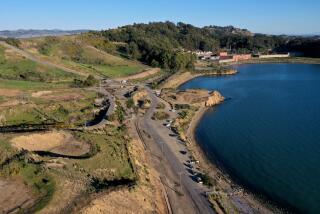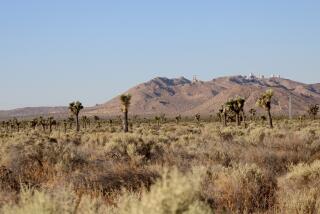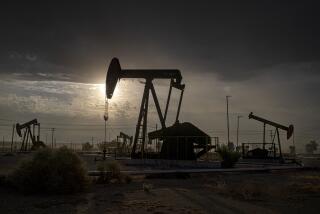Environmentalists feeling burned by rush to build solar projects
AMARGOSA VALLEY, Calif. — April Sall gazed out at the Mojave Desert flashing past the car window and unreeled a story of frustration and backroom dealings.
Her small California group, the Wildlands Conservancy, wanted to preserve 600,000 acres of the Mojave. The group raised $45 million, bought the land and deeded it to the federal government.
The conservancy intended that the land be protected forever. Instead, 12 years after accepting the largest land gift in American history, the federal government is on the verge of opening 50,000 acres of that bequest to solar development.
Even worse, in Sall’s view, the nation’s largest environmental organizations are scarcely voicing opposition. Their silence leaves the conservancy and a smattering of other small environmental organizations nearly alone in opposing energy development across 33,000 square miles of desert land.
“We got dragged into this because the big groups were standing on the sidelines and we were watching this big conservation legacy practically go under a bulldozer,” said Sall, the organization’s conservation director. “We said, ‘We can’t be silent anymore.’ ”
Similar stories can be heard across the desert Southwest. Small environmental groups are fighting utility-scale solar projects without the support of what they refer to as “Gang Green,” the nation’s big environmental players.
Local activists accuse the Sierra Club, the Natural Resources Defense Council, Defenders of Wildlife, the Wilderness Society and other venerable environmental groups of acquiescing to the industrialization of the desert because they believe large-scale solar power is essential to slowing climate change.
Janine Blaeloch, director of the Western Lands Project, a small public lands watchdog group, said Gang Green’s members are compliant in order to make themselves more inviting to major foundations. In recent years, grants for projects focusing on climate change and energy have become the two top-funded issues in environmental philanthropy. Foundations have awarded tens of millions of dollars in grants to environmental groups that make renewable energy a top priority.
“It’s not that they solely and directly make decisions based on funding, but they keep their eyes open to what foundations want,” Blaeloch said.
As a result, “you’ve got enviros exactly where industry wanted them to be,” she said.
Big environmental organizations say they have agonized over how to approach the issue. They acknowledge that development can have irreversible effects on ecosystems. But they are reluctant to stand in the way of renewable energy projects they regard as a vital response to climate change, which they consider the nation’s most serious environmental challenge.
The Sierra Club, NRDC and Defenders of Wildlife filed suit last week to stop the troubled Calico solar project northeast of Los Angeles. But for the most part the big players have embraced solar development.
Instead of following the old adversarial formula of saying no to everything, they have adopted an approach they call, “Getting to yes.”
‘Green halo’ effect
Grass-roots groups say that strategy has failed to protect the desert. What’s worse, they say, is that the imprimatur of such groups as the Sierra Club has provided a ‘“green halo” to energy companies and the government — making it easy for them to ignore local environmental concerns.
Two major projects underway in the Mojave illustrate the divide between local and national groups.
Desert activists vigorously oppose the BrightSource Energy project in the east Mojave’s Ivanpah Valley and NextEra’s Genesis solar plant 20 miles west of Blythe. National groups have not mounted a strong challenge to either project.
When BrightSource was planning the Ivanpah installation, the big environmental players urged the firm to move the bulk of the project closer to Interstate 5 to avoid prime habitat for the desert tortoise, a protected species. The company responded by reducing its total footprint by 12%, which didn’t solve the problem.
After construction began, large numbers of desert tortoises were discovered. According to federal biologists, BrightSource is now responsible for relocating and caring for 95% of all the tortoises expected to be found on all solar project sites in the Mojave.
Some rank-and-file Sierra Club members had wanted to sue to stop the project altogether, but the group’s national board of directors vetoed that proposal in favor of a more neutral approach.
Separately, the Sierra Club has scolded some in the Southern California desert chapters for opposing solar projects. The national office issued a 42-page directive laying out the organization’s policy regarding renewable energy and instructed local chapters to fall in line.
“It was pretty clear that the national club policy was to foster large-scale solar,” said longtime Sierra Club member Joan Taylor. “I don’t know how many times I’ve heard that building solar in the desert is going to save the world.”
The NRDC’s involvement at Ivanpah was constrained by a conflict of interest: NRDC senior attorneyRobert F. KennedyJr. is a BrightSource investor.
Abandonment urged
On the Genesis project, the Sierra Club and others met with NextEra executives and urged the company to abandon its plans for the site out of concern that
it is too close to a wilderness area. In addition, local groups warned the developer that the site contained sensitive cultural resources.
The project went ahead, only to become embroiled in controversy over the discovery of Native American cultural artifacts that halted construction on one-fifth of the site.
The Interior Department’s plan to open a vast swath of desert to solar energy is another instance local activists say demonstrates the ineffectiveness of Big Green’s approach.
In late 2010, environmental groups worked with energy companies and the government on a policy that restricted development to 677,000 acres in designated solar zones. Environmentalists left the table believing Interior would refine the agreement to even further reduce the land open to development.
Instead, not long after that compromise, Interior said 21 million acres would be available for development through a variance process, a change that no one in the environmental community supported. If the plan is approved as expected, the nation’s leading environmental groups will have been outflanked by solar developers.
“The Sierra Club and the NRDC — their mission is to work on climate change” above all else, Sall said. “We refuse to compromise on that level.”
The smaller groups have formed their own alliance, Solar Done Right, that supports renewable energy in previously disturbed or low-conflict lands. “We can have renewable energy — we can have tons of it — and we can do it in all the right ways,” Sall said.
The Sierra Club’s Barbara Boyle, senior lead for energy issues, said she understands the frustration of smaller groups. “I can appreciate that it doesn’t seem that we have gotten what we want out of the process yet,” she said.
Asked if the big players had been outmaneuvered by solar developers, Boyle said, “That’s always possible.”
But she said her 30 years of working for environmental causes have taught her that “the way that we win is through incremental progress.”
“I have faith that we are going to get this right in the end,” Boyle said. “We have made some mistakes, and that’s really difficult. But it’s not just any kind of development that we are working on here. We feel the urgency of getting as much renewable energy in California as soon as we can.”
Leading environmental organizations fiercely dispute suggestions that they are influenced by major donors. But on solar development, they are fending off perceptions.
‘Big Solar’ proposal
Four years ago, the director of the Center for Energy Efficiency and Renewable Technologies in Sacramento wrote a document called “Big Solar.” The proposal by V. John White was a pitch for solar developers to hire his company to help roll out projects.
White is a former lobbyist for the Sierra Club and the NRDC. He also lobbies and consults for energy companies.
White wrote that developers could get cooperation from environmental groups by creating a $500,000 grant-making fund. The money
ostensibly was for campaigns to tout the virtues of solar power, but the implication was unmistakable:
Give money to co-opt Big Green.
In the memo, White singled out two organizations — the Sierra Club and the NRDC — for grants. White says the fund was never created. But the strategy, coming from a former environmental lobbyist, raised the antennae of critics and invited scrutiny of funding sources.
The Energy Foundation is among the major funders of environmental groups today. It receives its money from large endowments, although not from the energy industry, and makes grants to further the goal of renewable energy. Over the last five years, the foundation has made $150 million in grants for renewable energy efforts, including $8.5 million to the NRDC and $6.2 million to the Sierra Club.
The Sierra Club’s zeal to eliminate coal-fired power plants led it to praise natural gas as an acceptable “bridge fuel.” Club officials rewrote their gift acceptance policy when it was discovered that from 2007 to 2010 the organization accepted $26 million from individuals with or subsidiaries of Chesapeake Energy, one of the country’s largest natural gas companies.
At the NRDC, public lands attorney Johanna Wald bristled at the suggestion that she or the organization has taken it easy on solar projects in return for grant money.
“It’s ridiculous,” Wald said. “I’m working around the clock on these issues. I couldn’t be bought off, I haven’t been bought off and I won’t be bought off.”
White has become something of a kingmaker in California on renewable energy, deciding who will represent environmental interests on various planning groups overseeing renewable energy development.
Every appointee he has chosen came from a major environmental group that supports most solar development.
As insiders in the process, Gang Green has framed the issues, Sall said, “basically saying we have to pave over huge areas of the West with solar or we are all going to burn up with climate change.”
“That set a tone that we still have not overcome.”
Los Angeles Times researcher Maloy Moore contributed to this report.
More to Read
Sign up for Essential California
The most important California stories and recommendations in your inbox every morning.
You may occasionally receive promotional content from the Los Angeles Times.











